
101st man wearing disk on front of helmet
Luminous or fluorescent disks were issued on a limited scale to paratroops for the Normandy jump. These small disks were attached to the front or back of the helmet so that the men could see each other in darkness. In this article I try to give a detailed view on the variations that existed, as well as the containers they were issued in.
But first a word on who used them and how. It is often identified as a pathfinder item, but that is just talk to drive up the price in auctions. They are known to have been used by pathfinders and other paratroopers alike, so they weren’t specifically issued to pathfinders. I also have my doubts about the actual usefulness of these disks in combat.
It is true that these disks glow even in total darkness, without having to first shine a torch on them to charge them (even after more than 60 years!). With the same blackout that was in force throughout occupied Europe, we can assume that there was no ambient light that night of 5-6 June (streetlights, houses…), only German flak fire to ruin your night vision. Even so, the Normandy jump was on a full moon, so I think you would still have to be quite close to the man in front to make out the shine of the disk on his helmet.
The stuff inside that glows is radium, the same radio-active material that was used in wrist watches until the 1960s when they discovered that this may be harmful, especially when tampered with. Now they use tritium, which works even better, but won’t make you look like Homer Simpson after a while. They didn’t know quite how harmful the material was, but they were careful enough to mark each disk with ‘poison inside’ (radioactive material was classified at the time as a poison for the purpose of transportation) and to ship the disks in small lead-lined containers.
More about the precise composition of the glowing stuff at the bottom of this article.
Types of disks
While outwardly similar, various types of these disks intended for wearing on the person existed. I will focus here on the types used by paratroops: the tie-on type, clip-on type and pin-on type. There were other luminous disks that were larger in diameter, but were not intended to be worn on helmets. The names ‘deck marker’ and ‘bridge marker’ allude to their purpose. More details about the latter types can be found via the links to related articles below.
Tie-on type
This is the most common type, although it still fetches high prices at auctions. As with the other types, the radium center is covered by a dome-shaped glass cover which clicks into the backside, secured by two hollow rivets. The backside and rivets were made of blued sheet steel or zinc coated or blackened brass. The ties would go through the hollow rivets. The one pictured here came with a green woolen individual pouch and para cord ties. I have also seen such pouches made of lighter weight OD green cotton.
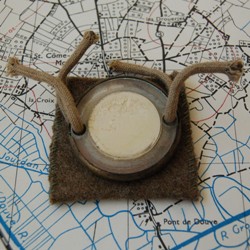 |
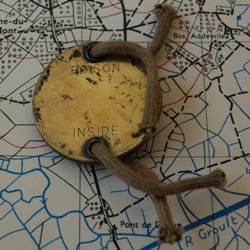 |
| Clip-on type front (click image to enlarge) | Clip-on type back (click image to enlarge) |
Clip-on type
This type is very rare, so more expensive. These only existed in blued steel and are mostly seen with some surface rust. In mint condition, these will cost you hundreds of dollars. The back is also marked with ‘POISON INSIDE’ and next to the clip, it can also be tied on by the hollow rivets.
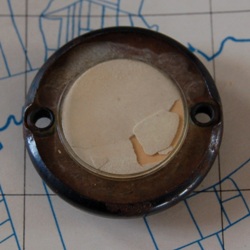 |
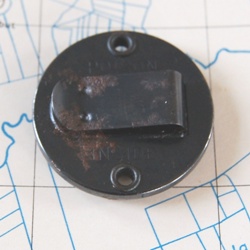 |
| Tie-on type front (click image to enlarge) | Tie-on type back (click image to enlarge) |
Pin-on type
This type is the rarest. So rare that I didn’t have a picture of it. But you could find one in Michel De Trez’s “The Point Of No Return”. Instead of the clip, it has a kind of safety pin at the back. I am told that these were not marked ‘poison inside’, but that they have the broad-arrow mark. That would label them as British issue, or so I thought.
That was until July 2015, when Joseph Muchanski sent me photos of his luminous disk with a pin back. It is not Broad Arrow marked but marked R.L.I. 1942. Under the pin is Pat. # 2336969. It is 1 1/2” in diameter. At first I tried searching the patent number, but I couldn’t find anything. That’s because it’s not a US patent number. The disk is not US but Canadian made. RLI stands for Radium Industries Limited. See photos below.
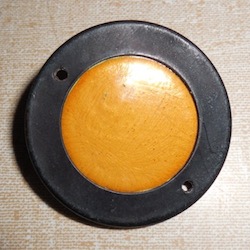 |
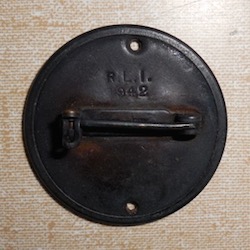 |
| Pin-on type front (click image to enlarge) | Pin-on type back (click image to enlarge) |
In October 2022, Kees Smulders sent these very clear pictures from a similar disk in his own collection. He bought it 30 years ago at an army surplus store in Arnhem. It’s a Canadian disk, complete with a nubuck leather pouch with a brass press stud, and a tie down cord. The patent number on the clip isn’t completely legible. It also ends with a 9, but in the middle there’s a 5, so it’s not the same number as on the example from Joseph Muchanski above.
Bridge markers
I found these pics of a bridge marker at an eBay auction. They are quite rare also, but outside the scope of this article. I thought I’d show one here anyway, just for comparison. This type is larger and has a threaded bolt at the back. More information about bridge markers can be found via the link at the bottom of this article.
 |
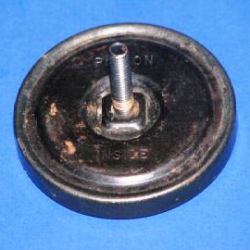 |
| Bridge marker front | Bridge marker back |
Eric Eaton sent me photos of screw-on type luminous disks, also known as bridge markers. They would be attached to bridges, buildings, vessels. He got this from a WW2 US Navy veteran, so presumably it would have been used on a vessel. Any further info on this is welcome! It’s the first time I’ve seen a photo of the box anyway.
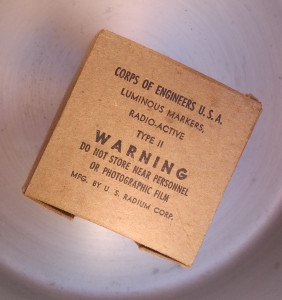 |
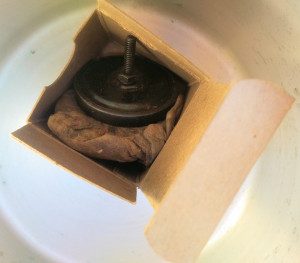 |
The large-type disk seen below is also what’s called a bridge marker, but besides two prongs with holes for nails or screws, it also has a regular clip for attaching it to a (helmet) net or to webbing. I didn’t have any good pictures of it until now. The seller was so kind to let me use his photos. He sold just one disk with the felt bag for $400 on eBay. The metal box was not for sale, but it is very interesting because it solves the TYPE I vs. TYPE III mystery (see below). Apparently, this type of disks belongs in the TYPE III-marked box, which has diagonal dividers inside (allowing for larger, but fewer disks). The TYPE 1 box has the smaller square dividers for the disks that were worn on helmets (mostly). The disk has a clip like the smaller disks for attaching it to the helmet net, the uniform or webbing, and two prongs with holes for nails. It is marked “USRC UNDARK 22m-TTR58 4-45 POSION INSIDE”. This was made April 1945.
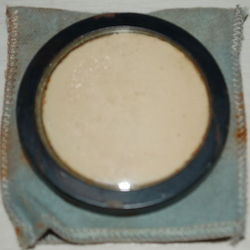 |
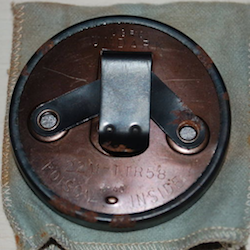 |
| Bridge marker front | Bridge marker back |
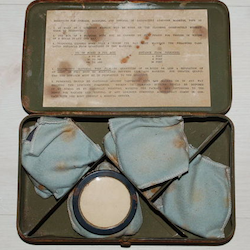 |
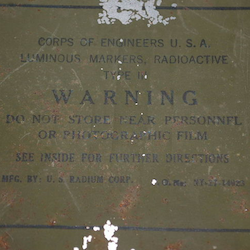 |
| Bridge marker in TYPE III box | Marking on TYPE III box |
I was allowed to take photos of another full box of bridge markers that were being sold at a show by QMI. It looks the same as the one in the pictures above. The disks also come in pouches. The date on these disks was March 1945.
Reproductions
Everything gets copied, so why not luminous disks. I can’t really recommend any of them as accurate copies, so better save up for one decent real one. The one in the pics below is from Milforce. It’s the clip-on type and it comes with a pouch.
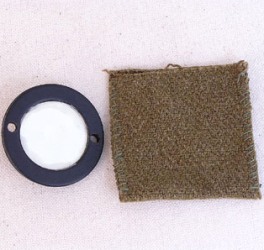 |
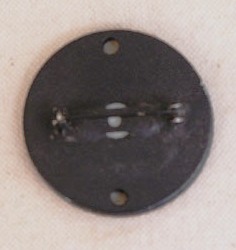 |
| Repro Milforce front | Repro Milforce back |
Types of boxes
As mentioned above, the disks were issued in lead-lined sheet metal containers. These are of course even harder to find than the disks themselves. I know of two types. They are virtually identical, but there are some small differences. Both were made by the U.S. Radium Corp., but stating different PO numbers.
 |
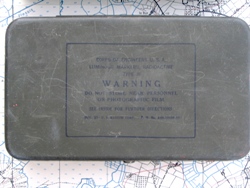 |
| Type I box (click image to enlarge) | Type III box (click image to enlarge) |
TYPE I box
The lid is stamped with TYPE I, otherwise the text of the stamp is identical to the one on the Type III box. From the side, you can see small protrusions, which are in fact slots for the internal dividers. These dividers are missing in my own box, but from pictures of other Type I boxes, I know that these are straight, leaving six spaces. The label on the inside of the lid has crumbled away. I have pieced-together the parts of the label for this photo. Again, this label is the exact same as in the type III boxes. Note that the lead lining has dried out and is completely disintegrated.
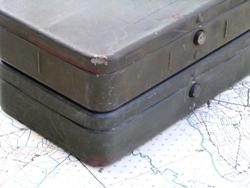 |
 |
| Top box is Type I with protruding slots for dividers (click image to enlarge) |
Label inside (click image to enlarge) |
TYPE III box
This box does not have the protrusions on the sides. The lock button is the same as on the Type I box. Inside is the exact same label, but the metal dividers are placed diagonally instead of straight, leaving only 4 slots instead of six. These slots are larger, so maybe this type of box was for the larger bridge / deck markers? I don’t know. The question is also if there ever was a Type II box.
Unmarked box
I have never seen a Type II box, but Paul Reijnders sent me these pictures of an unmarked box. It does not have a stamp on the outside, but otherwise its appearance is identical to the Type I box (protrusions outside and square dividers inside). Inside, the label has the same text, but a different font is used. Maybe a different manufacturer?
 |
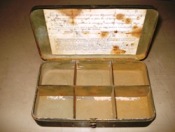 |
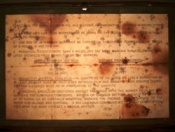 |
| Unmarked box (click image to enlarge) |
Straight dividers (click image to enlarge) |
Different font on label (click image to enlarge) |
None of these boxes are dated, but I would assume that the first type is the earlier version. This box is slightly more intricately made, but only in that it has the slots for the dividers. Any more definite theories are always welcome. The PO numbers could also be a clue for dating these items, but I am not familiar with these codes.
Risks of the radioactive radium
There has been quite some debate about how dangerous it is to keep these luminous disks in your collection. In May 2021, Jon Korsmo finally provided a clear and conclusive explanation that I can share with you here. He is a certified nuclear medicine technologist and works with radiation all day as a job.
Jon isn’t really worried about the radiation, but it depends on what you do with these disks.
It is very interesting that these things are still this radioactive this long. Jon can’t believe that the instructions say that you can wear 3 of these things indefinitely without problems! “There is no way I would wear one of these let alone 3″, John says.
As for the radiation, one disc is actually putting off a pretty large amount of radiation at the surface, i.e. on direct contact with the counter. That’s why it’s amazing the label said that 3 were safe to wear.
Radium decays via Alpha (95%) and Gamma (5%) particles, the alpha particles will mainly be blocked by the clear plastic and metal. The gamma on the other hand is what you need to worry about. If it’s on a shelf in a showcase and you are a few feet away then you should be perfectly fine. At a distance of 1 meter, the reading is just above normal background radiation. If you are 1 foot away from it you are getting around 150 mR/h or 1.5 millisieverts/hour. For comparison: a standard chest CT scan, which is a lot of radiation, is 8.0 millisieverts/h. So just to put it in perspective, if it’s on your shelf on display and you are standing 1 foot away then it would take 5.3 hours to absorb the same amount as the chest CT. So overall, it’s not super dangerous but it adds up over time. Note that this doubles with 2 disks. That’s still OK, but a full box of 24 markers should not be kept on display, especially if they are damaged or rusted.
As for contamination, it’s possible that a disk could contaminate the shelf it’s sitting on. Radium puts off radon gas as a byproduct. So it is possible that it contaminates anything it comes in contact with. But if it’s in good condition it’s pretty sealed in there. Jon says he wouldn’t worry about it and would certainly keep them displayed. What you could do just to be sure, is put a clear acrylic box over it for display and that would minimize any contamination.
Modern ‘cat-eyes’ and IFF patches
After discontinuing the issue of luminous disks sometime in the 1960s (as far as I can tell), a new type of luminous marking of helmets for night-time manoeuvres was again introduced in the 1980s for the then newly developed PASGT helmet. The picture on the left shows a helmet with an early ‘chocolate chip’ desert camo cover and an OD green elastic helmet band with two luminous ‘cat eyes’. These do not glow in the dark by themselves and have to be ‘charged’ with a flashlight. A later type (not shown here) has yellow reflective cat eyes. The latest ACH/MICH helmets have a flap at the top which can be opened to reveal a so-called IFF patch (Identification Friend or Foe). These are used for recognizing friendly troops from the air. Similar patches exist for wear on the uniform. You can see an example in the picture on the right. Click on the image to go to the website where I found it and find out more background on this.
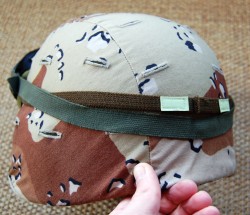 |
 |
| PASGT helmet with ‘cat eyes’ (click image to enlarge) |
IFF tab |
You can contribute too:
This article describes the variety of disks that I have, or have pictures of. I am especially interested in an explanation of the difference between the Type I and Type III boxes, and in the possible existence of a Type II box.

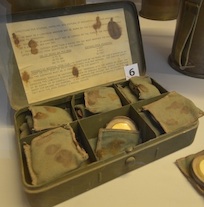
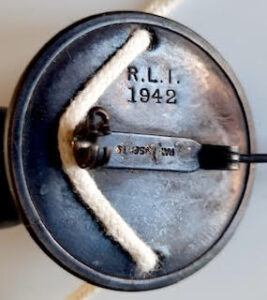
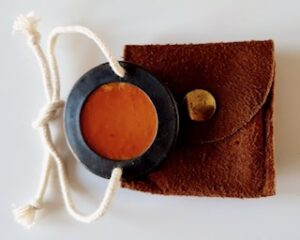
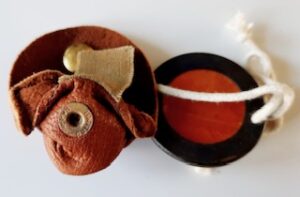
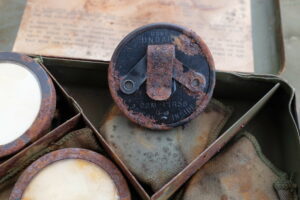
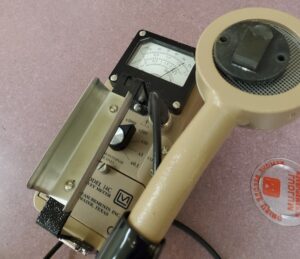

Hi,
FYI Selling a luminous disc unlike any in your collection. Please see here http://www.ebay.com/itm/300600288147?ssPageName=STRK:MESELX:IT&_trksid=p3984.m1555.l2649
Robert
Hi, be very careful with these discs – they contain a relative high amount of Radium 226. It’s somewhere about 5-15 uCi (microcuries). Do not store them near people. Carrying a box of 8 discs for a day would result in a big radiation dose (over the 1 year allowed limit). Radium also creates a radioactive gas – Radon. So never store the discs in closed rooms where other people stay for longer time. Never ever handle a broken disc – this would result in a serious contamination, which would be very difficult to clean.
Thanks for your warning and concern. I have two disks and keep them in a show case. Both are intact on the outside and little or no rust, but as you can see in the pics, the contents of one of them have broken up, but that’s inside. I try to touch them as little as possible. It’s an invisible hazard…
HI
great site I just discovered
can I have your e-mail because I have a few parts and would like more original etc. ..
thank you
fred
my email
fredmoi2011@hotmail.fr
sorry for my bad english
Soldiers would sew luminous tape to the back of their helmet covers and soft caps in the 70s . This may have dated back to Vietnam conflict. We were doing this when I was a pathfinder in the 82nd in 1979 .
I have a type II disc available for sale. Only one spot of surface rust, about 1/4 as much as the one shown above. contents inside appear to be a fine/ coarse mix of powder, and I can confirm that they are dangerously radioactive, since I have been using it to test several Geiger counters. Make an offer if interested. Email only. Will trade for silver bullion and/ or firearms.
My Email address is: jakedhughes @ gmail.com (without the spaces)
I have a type III lead lined box i recently aquired…how much is it worth?
It depends on the condition it is in. Does it have the dividers, is the label on the inside of the lid still intact, and what is its general appearance? I bought one for as little as 50EUR, but they can fetch 3 or 4 times that for a perfect one. I hope this helps.
I have found one of the tie on helmet markers with my metal detector intact and in pretty good cond. I didn’t know what it was for the last few months and have handled it probably more than I should just looking at the strange find. I thought it was just junk I am glad its not . How do I go about finding a collector interested in something like this?
If you don’t plan on keeping it, the best place to sell it is on eBay. If it’s rusty though (my guess, since you dug it up), it may be hard to sell.
Hello I’m writing a website about radiation and I want to ask, how about sending those discs abroda? It wouldbe a problem on borders?
Hello Mark, I don’t know really. I must have gotten mine via airmail years ago, but customs have become stricter. I personally wouldn’t dare anymore.
Regards, Wouter
thanks a lot! Ccould I use one of your photos on my website? I want to write a note about those discs :)- they are a great source of radiation and worn on head (despite metal helmet) they could serious health damage. The dose rate could be betwee 10 and 40 mR/h (100-400uSv/h)
Best reards 🙂
I have a wide collection of these, from the largest deck (bridge) markers in both with grommet holes and with threaded bolt attachment types) to the small personnel units (So much variety here, but I do believe I have all the combinations)…even two of the R.L.I. personnel units, all in cloth sachets they came in. When I collect, I collect until nothing is left…hah.
Anyway, while my collection is kept at university under 24-hour monitoring, I have made some purchases of these when they were located in other countries than the U.S. In the last 3 years I have purchased 4 (two of the largest bridge markers and my two RLI exemplars. Since I had no experience “importing” this item aside fro my job, I just let them be shipped as most authorities wii assign responsibility to conform with IATA, DOT, etc. to the shipping entity alone. I knew the ARAMs at the Intl Airports would detect them, and I was not disappointed! After the postman went, all I saw was a heavily repaired carton with green tape labeled with DHS – Inspected by DHS…
Never had an issue though as these items were made here.
I have completed dosimetry and radiometrology on all of the models and am willing to share the findings with anyone who asks.
Regards
J.
Great info Jonathan, and kudos to your complete collection 😉 Do you have the cardboard box too? I was sent a photo of these just recently. I have added it to the article.
I have three of the type II clip on style discs in perfect condition including the olive drab cloth pouch’s which they came in. Make me an offer.
Hello,
Mine.
http://souvenezvous44.blogspot.fr/2014/04/casque-para.html
I have the in my dad’s ww2 us navy days 1 of the clip on type. No metal box , it has been in a cardboard box in a desk drawer for many years. Looks to be in mint condition, no rust. He served fron 1940 to 1946, mostly in the Pacific. I have handled it this evening, not knowing what it was until i found this site. It is in tact. How should i store it? I would be willing to sell. I can email photo.
I just bought two complete type III boxes and the Larger bridge marker clip on discs disks
I found what I believe to be one today while on a beach in the US. The difference is what it stamped on the back of the marker, itself. I can’t find a picture of anything like it. Is there some where where I can post of pictures of it to get you guy’s opinions?
Hello Mike, happy new year! You can send a photo to paratrooper.be@gmail.com so I can post it for you. It sounds interesting.
Jonathan Smith, I would like to know about the radiation of the helmet disc. I have 1 my step father brought back home with him in WWII. I had 3 $2 Bill’s in the metal container for 3 or 4 years, but had no clue what the disc was until 3 weeks ago after I started carrying the $2 Bill’s in my wallet. I’m just curious if that would affect me.
Hello, I couldn’t tell you exactly, but I would advise not to carry the disk of the bills on your person. Just to be safe.
I have actually acquired an entire box of these type 1 clip type luminous markers. The box is in amazing condition. The inside contains 14 markers with 7 in their cloth pouch. Absolutely amazing find in my wife’s grandmother’s basement. If you want pictures shoot me an email. Not sure what to do with them to ve honest but thought it was so cool to find a ww2 relic in awesome condition.
I have a box of 14 clip type 1 markers in the original box. 7 of the markers have the original cloth covering and 7 more do not. I have not seen a complete box in this condition anywhere other than that picture you have of the one in the museum. Its in fantastic shape but i have no idea what a set would be worth or if i should just piece them out or where to even sell them for that matter. Any info would be appreciated.
Hi Johnathan, I am very enthusiastic about these items and have been collecting them for years. I’d be interested in purchasing some of your disks if they are still available. You can email me at: mountaineer1001@outlook.com
Hi sir have you one disk for sale?
I life in Belgium sir
Best regards michel
No I don’t, but I’ll post your comment here so maybe someone else can react if they’re selling one.
I recently purchased a luminous disc on ebay and i was wondering if anyone has any leads on an original bag or box and would be interested
Hello Eric, where do you live? The boxes occasionally turn up on classifieds sites in Europe. The bags (without discs) are very rare.
Hello I’m currently selling a ww2 luminous disc with original cloth cover on eBay .Have I’d or paratrooper who sent it home.He was unfortunately killed a few weeks after dday.incredible item.
I’m looking for a bridge marker type of disk. I’ve never had one and would really like to find one for my humble little collection. Anyone out there willing to sell me one out of their own collection? I’d love to purchase one of these. Contact me if interested, thank you! Jeffat24@yahoo.com